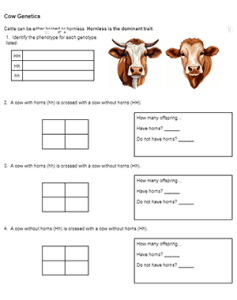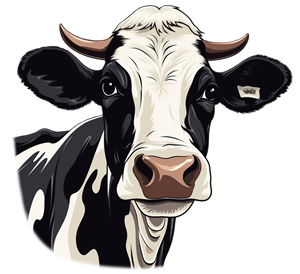
Students practice genetic crosses with this activity showcasing cows. Who doesn’t love cows! This is a great follow-up activity to “Peas, Please” which explores basic Mendelian genetics.
The first page explores the trait of horns in cows, which is a recessive trait. Generally, farmers who raise cows prefer the hornless variety, for safety reasons. Because the trait is recessive, it is possible for two cows without horns to have a baby with horns. Both parents would be carrying the recessive allele for horns (Hh x Hh).
In most cattle the horn/poll gene action is simple recessive with the poll allele (P) being dominant to the horn allele (p).
Polled is a trait in cows where they do not have horns. Sometimes, hornless cows can have scurs, or incomplete horn growth. We do not fully understand how scurring occurs, but is likely inherited separately from the poll gene.
The worksheet has Punnett squares for students to complete and then write in the phenotypic ratios. They can write as a percentage or as a fraction. Students then predict whether the offspring will have horns or be hornless (polled).
Cow Colors
On the second page, students explore the concept of codominance. Though color in cows is more complicated than what is explored here, the simplification is helpful for beginning biology students.

If you want to explore further color patterns in cows, Okstate.edu has a good overview of the different patterns.
Students determine the phenotypes for Red (RR), white (rr) or roan (Rr). Some textbooks use s different system for genotype where capitals letters are used; RW would be roan. I find adding extra letters causes confusion with beginning students. They’ll start using capital letters for even simple (non-codominant) crosses. For fun, I have several cow figurines and ask students to suggest a phenotype.
You can also mix things up with black and brown cows. Black is dominant to red, and both black and red are co-dominant with white. One black or red allele with a white allele would result in either a black or red roan animal.

